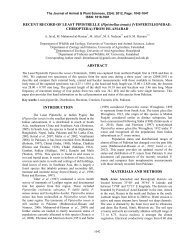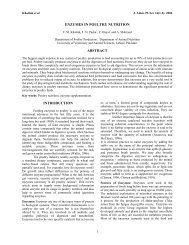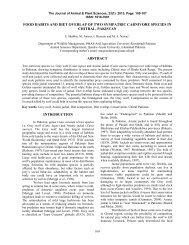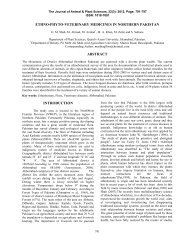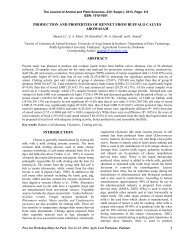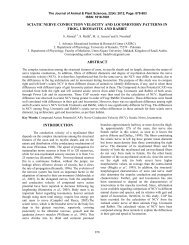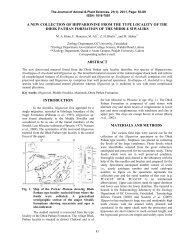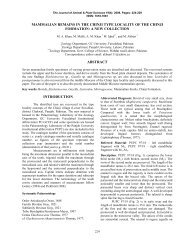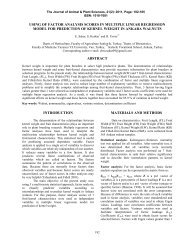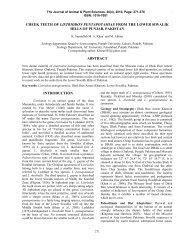ethnobotanical study about medicinal plants of poonch valley
ethnobotanical study about medicinal plants of poonch valley
ethnobotanical study about medicinal plants of poonch valley
Create successful ePaper yourself
Turn your PDF publications into a flip-book with our unique Google optimized e-Paper software.
Khan et al., The Journal <strong>of</strong> Animal & Plant Sciences, 22(2): 2012, Page: J. 493-500 Anim. Plant Sci. 22(2):2012<br />
ISSN: 1018-7081<br />
ETHNOBOTANICAL STUDY ABOUT MEDICINAL PLANTS OF POONCH VALLEY<br />
AZAD KASHMIR<br />
M. A. Khan * , M. Ajab. Khan, G. Mujtaba and M. Hussain<br />
* Department <strong>of</strong> Plant Sciences, Quaid-i-Azam University, Islamabad 45320, Pakistan.<br />
Department <strong>of</strong> Microbiology, Quaid-i-Azam University, Islamabad 45320, Pakistan.<br />
Correspondence Author: muhammadazam87@yahoo.com<br />
ABSTRACT<br />
This <strong>study</strong> contributes to <strong>ethnobotanical</strong> knowledge <strong>of</strong> Poonch <strong>valley</strong>, Azad Kashmir (Northern Pakistan). In the area<br />
studied, <strong>medicinal</strong> <strong>plants</strong> play significant role among farmers, shepherds and other people who live in villages and<br />
remote areas. The <strong>plants</strong> collected, indicated by the locals, were identified according to “Flora <strong>of</strong> West Pakistan”. The<br />
voucher specimens were deposited in Quaid-i-Azam University Herbarium. A total 56 <strong>medicinal</strong> plant species belonging<br />
to 36 families are listed in this paper. The botanical and vernacular names, their respective family names, part <strong>of</strong> the<br />
plant used and their uses are indicated. Acanthaceae, Asteraceae, Lamiaceace, Liliaceae, Ranunculaceae and<br />
Verbenaceae are the families most frequently present in <strong>study</strong> area, while Brassicaceae, Caesalpinaceae, Mimosoideae<br />
and Cyperaceae are almost absent. The uses <strong>of</strong> the recorded species relate to minor ailments mainly those <strong>of</strong> the urinary<br />
tract infection (UTI) and kidney stone (13 species), diarrhoea (12 species), respiratory disorder (10 species), Asthma (9<br />
species) and rheumatic (6 species ). The results <strong>of</strong> this survey suggest that the indigenous knowledge related to the<br />
recorded species uses came from women aged between 29-50 years whereas in this <strong>study</strong> the folk <strong>medicinal</strong> uses come<br />
from men.<br />
Key words: Ethnobotanical <strong>study</strong>, Medicinal <strong>plants</strong>, Poonch <strong>valley</strong>, Phytosociology.<br />
INTRODUCTION<br />
The history <strong>of</strong> medicine and surgery dates back<br />
perhaps to the origin <strong>of</strong> the human race. Use <strong>of</strong> <strong>plants</strong> as<br />
a source <strong>of</strong> medicine has been inherited and is an<br />
important component <strong>of</strong> the health care system in<br />
different countries <strong>of</strong> the world.<br />
Traditional Unani medicine is a part <strong>of</strong> Pakistan<br />
culture. Pakistan is included in those countries where<br />
traditional Unani medicine is popularly practiced among<br />
the large segment <strong>of</strong> populations, the Unani medicine<br />
system originated in Greece was found by old ancient<br />
Greek philosophers. It was documented and adopted by<br />
Muslims the glorious period <strong>of</strong> Islamic civilization.<br />
Unani medicine system was brought to the Indo<br />
– Pak subcontinent by Muslims scholars and practiced it<br />
for centuries. It benefited from the Ayun system <strong>of</strong><br />
medicine, which was an important component <strong>of</strong> Hindu<br />
civilization. Traditional Unani medicine heavily depends<br />
on <strong>medicinal</strong> <strong>plants</strong>, apart from the animals and minerals<br />
(Good man et al; 1995).<br />
Thus, despite the rich heritage <strong>of</strong> knowledge on<br />
the use <strong>of</strong> plant drugs, little attention had been paid to<br />
grow them as field crops in the country till the latter part<br />
<strong>of</strong> the nineteenths century. Pakistan is bestowed with<br />
unique biodiversity, comprising <strong>of</strong> different climatic<br />
zones and a wide range <strong>of</strong> plant species. The country has<br />
<strong>about</strong> 6000 species <strong>of</strong> wild <strong>plants</strong> <strong>of</strong> which <strong>about</strong> 600 are<br />
493<br />
considered to be medically important (Hamayun et al:<br />
2003).<br />
The northern areas <strong>of</strong> Pakistan comprising<br />
Himalayas, Karakarum, Hindukush and Kashmir are<br />
under the tremendous pressure from local people<br />
generally and visitor’s particularly. It is because <strong>of</strong><br />
indiscriminate uprooting, poor collection and storage<br />
methods <strong>of</strong> <strong>medicinal</strong> <strong>plants</strong>. In an age when toxic drugs<br />
are increasing unwelcome and when thinking people are<br />
using viable alternatives Pakistan’s <strong>medicinal</strong> heritage<br />
must be documented, saved and used. During the past<br />
decade, a dramatic increase in exports <strong>of</strong> <strong>medicinal</strong> <strong>plants</strong><br />
alerts to worldwide interest in these products as well as in<br />
traditional health systems. But with most <strong>of</strong> these <strong>plants</strong><br />
being taken from the wild, hundreds <strong>of</strong> species are now<br />
threatened with extinction because <strong>of</strong> over harvesting<br />
destructive collection techniques, and conversion <strong>of</strong><br />
habitats to crop based agriculture. Hence it becomes<br />
necessary to conserve, cultivate and properly utilize the<br />
<strong>medicinal</strong> <strong>plants</strong> for sustainable development <strong>of</strong> the<br />
country.<br />
Poonch Valley, from the <strong>ethnobotanical</strong> point <strong>of</strong><br />
view, is one <strong>of</strong> the least investigated area <strong>of</strong> the Azad<br />
Kashmir with exception <strong>of</strong> a few contributions made by<br />
Ishtiaq (2001), Khan et al. (1985) and Sadique (1991).<br />
This research is focused on a limited area: Azad Patten,<br />
Palandri, Rawalakot, Tian, Shaheed-Galla, Toulipir, Lus<br />
Danna, Mehmood Gali, Basari, Badri Galli, Ghamir,<br />
Kharanj, Chunjal Hill and Gorah.
Khan et al., J. Anim. Plant Sci. 22(2):2012<br />
Study area and the people: Systematic explorations <strong>of</strong><br />
traditional uses <strong>of</strong> <strong>plants</strong> are urgently required in Poonch<br />
Valley <strong>of</strong> Azad Kashmir especially because <strong>of</strong> its<br />
geographical, historical reasons and hilly terrain<br />
(relatively isolated). Moreover, modern development has<br />
not leaded a complete decline <strong>of</strong> traditional knowledge.<br />
Azad Jammu and Kashmir is a fascinating land <strong>of</strong> people,<br />
language and culture. The texture <strong>of</strong> present population is<br />
composed <strong>of</strong> races claiming descents from Semitic,<br />
Mongoloid, Aryans, Persians, Turks and Arabs.<br />
The culture <strong>of</strong> this area resembles to that <strong>of</strong> the<br />
adjacent area <strong>of</strong> Punjab. The people <strong>of</strong> Kashmir are very<br />
loud, and vocal, very persistent. They are very quick in<br />
argument and they never abandon a case unless they are<br />
convinced, and they always insist on knowing the<br />
grounds <strong>of</strong> a decision. The area has both cultures, rural<br />
and urban.<br />
The people <strong>of</strong> Poonch <strong>valley</strong> are poor and the<br />
area is highly under developed. Local people are<br />
primarily farmers or tenants. They also rear livestock.<br />
The area, particularly, the foothills and plains, has an<br />
agricultural economy mainly dependent on rainfall.<br />
Maize, wheat, rice are the main crops and beans and peas<br />
are also cultivated in the area. Among fruits; apples,<br />
apricots, peaches, walnuts, plumbs, pears, and citrus are<br />
grown and are exported from the area. Some people<br />
collect <strong>medicinal</strong> <strong>plants</strong> and morels and sell it in local<br />
markets, thus earning their livelihood. The people also<br />
earn by selling handicrafts such as Namda, Gubba, Patto,<br />
Woolen shawls etc.<br />
The traditional practitioners (herbal doctors) are<br />
playing an important role in providing health coverage to<br />
75% <strong>of</strong> the population residing in villages and rural areas.<br />
A variety <strong>of</strong> herbal products have been used by the herbal<br />
doctors for the treatments <strong>of</strong> various diseases common in<br />
the area. The elder people <strong>of</strong> the area, even in these days,<br />
use local plant resources to cure many common diseases<br />
<strong>of</strong> children especially. The knowledge and experience <strong>of</strong><br />
these elderly people (men and women) is a precious<br />
wealth <strong>of</strong> the area. The present <strong>study</strong> was conducted for<br />
systematic documentation <strong>of</strong> this knowledge on use and<br />
production <strong>of</strong> <strong>medicinal</strong> <strong>plants</strong>.<br />
Medicinal <strong>plants</strong>: Medicinal <strong>plants</strong> possess active<br />
chemical constituents which produce a definite curing<br />
physiological response in the treatment <strong>of</strong> various<br />
ailments in human and animals. A simple illustration <strong>of</strong><br />
synthetic drug verse plant extract is with aspirin and the<br />
bark <strong>of</strong> Salix alba (white willow). The bark <strong>of</strong> Salix alba,<br />
contain saliein formed the basis for making aspirin<br />
((Chevallier, 1998)). In many people, aspirin cause a side<br />
effect that can be avoided by using an extract <strong>of</strong> Salix<br />
bark (Shinwari and Gilani, 2003). Non–nutrient<br />
phytochemicals are increasingly being recognized as<br />
potential health promoters in reducing the risks <strong>of</strong><br />
cardiovascular disease and arteriosclerosis. Prominent<br />
494<br />
herbs identified were Achillea millefolium (yarrow),<br />
Allium sativum (garlic), and Convallaria majalis (Lily <strong>of</strong><br />
the <strong>valley</strong>) Crataegus laevigata (Hawthorn), Cynara<br />
scolymus, Gingko biloba (gingko) and Viburnum opulus<br />
(cramp bark). Saint Johnswort known as johanniskra in<br />
German for centuries has been used to treat people with<br />
mild and moderate depression without the side effect <strong>of</strong><br />
Prozac.<br />
MATERIALS AND METHODS<br />
The research was conducted in several potential<br />
stands <strong>of</strong> the areas. For data collection, 35 informants,<br />
mostly native to the area mainly farmers, shepherds and<br />
housewives were interviewed. Interpretation <strong>of</strong> the<br />
information received into technical or <strong>medicinal</strong> terms<br />
was carefully avoided so as to have a true picture <strong>of</strong><br />
customs and uses. The information was usually imparted<br />
in the local dialect, and <strong>plants</strong> were indicated with<br />
vernacular names. The informants were aware <strong>of</strong> the aims<br />
and the end use <strong>of</strong> informations they provided. They also<br />
collaborated in collecting and recognizing <strong>plants</strong>.<br />
Moreover, they also indicated, where <strong>plants</strong> were easily<br />
available. After having collected the species, the lists<br />
were prepared and then identified according to the<br />
nomenclature <strong>of</strong> Flora <strong>of</strong> West Pakistan by Stewart<br />
(1972). The voucher specimens were submitted to<br />
Herbarium <strong>of</strong> Quaid-i-Azam University Islamabad (ISL).<br />
The methods included two stages:<br />
I) Field Work: The <strong>study</strong> trips were made from January<br />
to May and from July to December (twice a month) for<br />
three years (2000 - 2003). The field work was based on<br />
observations, interviews and guided field trips. Two<br />
methods for collecting information were used during the<br />
field work<br />
a) Observations: The observations were made in the<br />
upland during herbal growth <strong>of</strong> the <strong>plants</strong> species, which<br />
were collected, dried and identified. Harvesting time,<br />
processing and their utilization were recorded. All the<br />
<strong>plants</strong> were collected during their flowering season<br />
(stage). The specimens were deposited in Quaid-i-Azam<br />
University Islamabad herbarium as voucher specimens.<br />
b) Interviews: Extensive surveys were carried out during<br />
the field work; interviews were conducted with the local<br />
inhabitants, the herbalists, ‘Hakims’ (local physicians).<br />
About 40 informants were interviewed on random basis.<br />
Three questionnaires were used during the survey for<br />
information <strong>about</strong> the plant resources, quantities used,<br />
rate <strong>of</strong> consumption, availability and percentage <strong>of</strong> <strong>plants</strong><br />
species found and their utilization by the people.<br />
II) Documentation: The <strong>ethnobotanical</strong> data obtained<br />
was checked and compared with the existing literature<br />
and was analyzed both quantitatively and qualitatively.<br />
Hence the indigenous knowledge <strong>about</strong> plant resources,<br />
religious and cultural aspects such as population diversity
Khan et al., J. Anim. Plant Sci. 22(2):2012<br />
was also documented. For <strong>ethnobotanical</strong> inventory, four<br />
criteria, who, what, how and when, were used. For<br />
example, who collects the <strong>plants</strong>? Who is responsible for<br />
their destruction? What are the uses <strong>of</strong> plant resources?<br />
What are destructive agencies? What types <strong>of</strong> benefit are<br />
obtained from natural resources to the local<br />
communities? How ethnobotanists and conservationists<br />
were successful in knowing what is happening to the real<br />
picture <strong>of</strong> natural ecosystem? When flora is available in<br />
full grown state with root, stem, leaves and flowers?<br />
Ethnobotanical inventory consisted <strong>of</strong> botanical names,<br />
vernacular/local names; few needed synonyms, localities,<br />
its elevation and its ecological status.<br />
Market Assessment: Market assessment <strong>of</strong> <strong>medicinal</strong><br />
<strong>plants</strong> available in the markets <strong>of</strong> Abbaspur, Hajira,<br />
Rawalakot and Trarkhel was carried out. Marketing chain<br />
for <strong>medicinal</strong> <strong>plants</strong> collection and people involved in<br />
<strong>medicinal</strong> <strong>plants</strong> trade was investigated. A list <strong>of</strong><br />
economic <strong>plants</strong> was prepared with emphasis on plant<br />
market availability status, collection methods and local<br />
prices <strong>of</strong> these <strong>plants</strong>. The available literature on the<br />
market survey was also collected and made a review from<br />
it to compare it with present findings.<br />
Recorded data were compared with specific<br />
<strong>ethnobotanical</strong> literature, not limited only to Poonch<br />
Valley, in order to identify analogies, differences or<br />
eventual uses not cited previously. Gottesfeld (1994) ,<br />
Bhatt and Guar (1992) , Omino and Kok-Waro (1993) ,<br />
Leporatti and Lattanzi (1994), Khan (1985), Farooq<br />
(1990), Good man and Ghafoor (1995 ), Ansari et al.<br />
(1993), Haq (1993), Siddiqui et al. (1991), Haq and<br />
Hussain (1995), Sadaqat (1995) , Ahmad (2003),<br />
Muhammad Ishtiaq et al. (2001).<br />
RESULTS<br />
In table 1, out <strong>of</strong> 56 species belonging to 36<br />
families, only 14 are listed. Botanical, vernacular name,<br />
part <strong>of</strong> the plant used and approximate annual yield are<br />
reported.<br />
Medicinal <strong>plants</strong> <strong>of</strong> Poonch <strong>valley</strong>: A large proportion<br />
<strong>of</strong> the population <strong>of</strong> the <strong>valley</strong> living in the far-flung<br />
areas still relies on <strong>medicinal</strong> <strong>plants</strong> for curing different<br />
aliments. The people <strong>of</strong> these areas depend on the local<br />
<strong>medicinal</strong> <strong>plants</strong> because no <strong>medicinal</strong> facilities are<br />
available in these areas. It was also observed that people<br />
have no accessibility and affordability for pharmaceutical<br />
medicines. Present <strong>study</strong> includes 56 <strong>medicinal</strong> <strong>plants</strong><br />
which makes 40.23 % <strong>of</strong> the total plant species used in<br />
area for different purposes.<br />
Some important <strong>medicinal</strong> <strong>plants</strong> were collected<br />
and used in the area are Gallium elegans, Bergenia<br />
ciliata, Dioscoria deltoidea, Viola biflora, Trichodesma<br />
indicum, Pistacia integerrima, Podophyllum emodi,<br />
Polygonum amplexicaule, Geranium wallichianum,<br />
495<br />
Achillea millefolium, Desmodium podocarpum, Melia<br />
azedarach, Onoclea vecunifolium, Punica granatum,<br />
Rumex hirsuta, Zanthoxylum alatum and Micromeria<br />
biflora.<br />
A survey was conducted in order to see the<br />
source <strong>of</strong> indigenous knowledge <strong>about</strong> medical uses <strong>of</strong><br />
<strong>plants</strong> in the research area. The data revealed that 72% <strong>of</strong><br />
folk <strong>medicinal</strong> knowledge comes from people above the<br />
age <strong>of</strong> 50 years while 28% <strong>of</strong> it comes from people<br />
between ages <strong>of</strong> 30 and 50 years. Gender wise, men<br />
especially old ones were more informative <strong>of</strong> traditional<br />
knowledge <strong>of</strong> <strong>medicinal</strong> <strong>plants</strong> than women in the area.<br />
The survey also indicated that <strong>about</strong> 45% <strong>of</strong> the local<br />
population was dependent on medical <strong>plants</strong> for curing<br />
different aliments. The dependency on <strong>medicinal</strong> <strong>plants</strong><br />
dropped over the last five year as the area was ramified<br />
by link roads and shops <strong>of</strong> allopathic drugs were opened.<br />
It was also observed that <strong>about</strong> 60% <strong>of</strong> the home made<br />
drugs were used by people above the age <strong>of</strong> 50 years,<br />
30% by children below age <strong>of</strong> 15 years especially infants.<br />
While remaining 10% <strong>of</strong> the traditional medicines <strong>of</strong><br />
<strong>plants</strong> origin are utilized by people between age <strong>of</strong> 15 and<br />
50 years.<br />
Marketing status <strong>of</strong> <strong>medicinal</strong> <strong>plants</strong>: The inhabitants<br />
<strong>of</strong> Poonch <strong>valley</strong> sell <strong>about</strong> 30 <strong>medicinal</strong> plant species in<br />
the local market commercially. These plant species are<br />
collected in the area during April to August. Only 8<br />
species <strong>of</strong> them traded in national markets while rest was<br />
used locally.<br />
The <strong>medicinal</strong> plant species are under intense<br />
pressure; as market provide main source <strong>of</strong> supply to herb<br />
trades and herbalists practicing in urban areas. The<br />
species like Abies pindrow, Berberis lyceum, Bergenia<br />
ciliata, Caryopteris odorata, Dioscoria deltoidea,<br />
Gallium elegans, Geranium wallichianum, Mallotus<br />
philippensis, Pistacia integerrima, Punica granatum,<br />
Rumex hirsuta, Trichodesma indicum, Viola biflora,<br />
Zanthoxylum alatum, Ziziphus oxyphylla, Sapindus<br />
saponaria and Daphne papyracea are traded to local and<br />
national markets.<br />
A survey conducted during present <strong>study</strong><br />
showed that <strong>medicinal</strong> <strong>plants</strong> gatherers include men<br />
(52%), women (21.26%) and children (26.74%) . About<br />
95% <strong>of</strong> these <strong>medicinal</strong> <strong>plants</strong> are sold in the local market<br />
in fresh form, as gatherers are poor and needy. Some<br />
species are cleaned, dried in the sun and stored in plastic<br />
bags. The collectors carry with them digging tools and<br />
dig <strong>medicinal</strong> <strong>plants</strong> wherever found.<br />
The <strong>study</strong> also showed that the number <strong>of</strong><br />
<strong>medicinal</strong> <strong>plants</strong> decreased during the past 15 years.<br />
Response to the question “ what is the availability status<br />
<strong>of</strong> <strong>medicinal</strong> <strong>plants</strong> <strong>of</strong> the area, an aged villager said,<br />
<strong>medicinal</strong> <strong>plants</strong> were abundant in the vicinities <strong>of</strong> human<br />
settlements some 15 years back. However, the population<br />
<strong>of</strong> the <strong>medicinal</strong> <strong>plants</strong> drastically decreased due to the
Khan et al., J. Anim. Plant Sci. 22(2):2012<br />
high rate <strong>of</strong> population growth, stimulus <strong>of</strong> commercial<br />
trade in the <strong>medicinal</strong> <strong>plants</strong> and increased marketing<br />
pressure on the <strong>medicinal</strong> <strong>plants</strong>. It was also observed<br />
that the potential area <strong>of</strong> the <strong>valley</strong> visited by the<br />
Table: 1. Important <strong>medicinal</strong> plant species <strong>of</strong> Poonch <strong>valley</strong><br />
496<br />
commercial gatherers (Nomad and Quack) duri ng<br />
summer and raining season with their goats and sheep<br />
herds collect useful <strong>medicinal</strong> <strong>plants</strong>.<br />
No Botanical Name Local Name Part used Approximate annual yield (Kg.)<br />
1 Berberis lyceum Sumbalu Roots 180<br />
2 Bergenia ciliata Butpue Rhizome 165<br />
3 Caryopteris odorata Bahata jari Leaves 155<br />
4 Dioscoria deltoidea Kala ganda Roots 200<br />
5 Galium elegans Jari pneumonia Roots 140<br />
6 Geranium wallichianum Ratanjo Roots 160<br />
7 Mallotus philippensis Kamela Fruits 175<br />
8 Pistacia integerrima Kakra Pod 165<br />
9 Punica granatum Daruna Fruits 190<br />
10 Trichodesma indicum Handusi Plant 150<br />
11 Viola biflora Banafsha Flower/whole plant 155<br />
12 Zanthoxylum alatum Timber Fruits 195<br />
13 Sapindus saponaria Rantha Fruits 500-600<br />
14 Colchicum luteum Mamona Rhizome 140<br />
Table: 2. Methods <strong>of</strong> traditional medicine preparation<br />
Method <strong>of</strong> preparation Number <strong>of</strong> species Percent<br />
Aqueous extract 28 46.67<br />
Powdering 14 23.33<br />
Decoction 09 15<br />
Poultice 03 05<br />
Smoking 03 05<br />
Mixture 02 3.33<br />
Pasting 01 1.67<br />
Ointment 01 1.67<br />
Ashing 01 1.67<br />
The <strong>medicinal</strong> <strong>plants</strong> are collected in large number from<br />
remote areas <strong>of</strong> Lus Danna, Mehmood Gali, Gohri Mar,<br />
Pirdkot, Char Biar and Gala Kanut. Most <strong>of</strong> the <strong>medicinal</strong><br />
<strong>plants</strong> <strong>of</strong> the <strong>valley</strong> are sold in the local market <strong>of</strong> Bagh,<br />
Kahuta, Hajira, Rawalakot, Khai Gala and Palandri. The<br />
data relating to botanical name, local name, plant part<br />
used and approximate annual yield (Kg) was given in<br />
table 1.<br />
Fig.1. Gender and age wise distribution <strong>of</strong> folk<br />
<strong>medicinal</strong> knowledge and its utility in Poonch<br />
<strong>valley</strong>.<br />
Fig. 2 Distribution <strong>of</strong> the plant species and proportion<br />
<strong>of</strong> disease treated.<br />
Fig.3. Percentage distribution <strong>of</strong> methods <strong>of</strong> the<br />
medicine preparation.<br />
Common health problems in the <strong>study</strong> area: A total <strong>of</strong><br />
40 diseases were reported by the traditional medicine<br />
practitioners <strong>of</strong> the <strong>study</strong> area. The most recurrently<br />
reported health problems were urinary tract infection and
Khan et al., J. Anim. Plant Sci. 22(2):2012<br />
kidney stone, diarrhoea, cough and asthma. The local<br />
people used <strong>about</strong> 13 and 12 <strong>medicinal</strong> <strong>plants</strong> to treat the<br />
first two diseases, 10 <strong>medicinal</strong> <strong>plants</strong> to treat cough, 09<br />
to treat asthma, 07 to treat abdominal worm and sexual<br />
disorder.<br />
The local people employed several methods in<br />
order to prepare medicines from these <strong>plants</strong>. However,<br />
aqueous extract (28 species, 46.67%) followed by<br />
powdering (14 species, 23.33%) and decoction (09<br />
species, 15%) were the most frequently used methods <strong>of</strong><br />
medicine preparation. The majority <strong>of</strong> these preparations<br />
were drawn from mixture <strong>of</strong> different plant species for<br />
the treatment <strong>of</strong> a single disease. With regard to the plant<br />
parts used for <strong>medicinal</strong> purposes local people mostly<br />
Fig. 4.<br />
Medicinal plant conservation efforts <strong>of</strong> the local<br />
people: About 21.62% <strong>of</strong> the informants interviewed had<br />
some kind <strong>of</strong> awareness in conserving some <strong>medicinal</strong><br />
plant species that were relatively scarce in their<br />
surroundings. These informants were practicing some<br />
conservation activities like cultivation in and around<br />
home gardens <strong>of</strong> <strong>about</strong> 26.67% <strong>of</strong> the total <strong>medicinal</strong><br />
497<br />
harvested leaves (22 species, 36.67%) followed by roots<br />
(15 species, 25%).The majority <strong>of</strong> the ailments were<br />
treated with fruit, flower, seeds, stem and rhizomes.<br />
Major threats to <strong>medicinal</strong> <strong>plants</strong> <strong>of</strong> the area: Major<br />
<strong>medicinal</strong> <strong>plants</strong> in the <strong>study</strong> area were highly threatened<br />
with anthropogenic and natural factors. The majority <strong>of</strong><br />
<strong>medicinal</strong> <strong>plants</strong> (16 species, 26.6%age) were reported to<br />
be threatened with agricultural expansion, deforestation<br />
and forest occupation. Analysis <strong>of</strong> data regarding the<br />
status <strong>of</strong> <strong>medicinal</strong> <strong>plants</strong> showed that, <strong>about</strong> 16 (26.7 %)<br />
<strong>of</strong> the <strong>medicinal</strong> plant species to be abundant whereas 19<br />
(31.67%) species to be very rare.<br />
plant species. The rest <strong>of</strong> the informants were not<br />
practicing any pronounced conservation effort. They<br />
simply went to the field, home garden or farmland to<br />
collect <strong>medicinal</strong> <strong>plants</strong> as their need arose and did not<br />
bother <strong>about</strong> the long term survival <strong>of</strong> these <strong>plants</strong>.<br />
The <strong>plants</strong> collected are washed with water to<br />
remove mud attached to the <strong>plants</strong>. Major proportions <strong>of</strong>
Khan et al., J. Anim. Plant Sci. 22(2):2012<br />
<strong>plants</strong> collected are sold in fresh while some <strong>plants</strong> are<br />
stored in bag and sacks from one week to one year.<br />
Before storing these <strong>plants</strong> are washed and kept under the<br />
sun for drying. The <strong>plants</strong> are sold in the local markets<br />
while some <strong>of</strong> them are kept in homes for curing different<br />
ailments. During storage considerable amount <strong>of</strong><br />
<strong>medicinal</strong> <strong>plants</strong> are wasted due to humidity, insect<br />
attaches, inappropriate storage facilities and lack <strong>of</strong><br />
awareness on the part <strong>of</strong> the collectors.<br />
The collectors included men, women, children,<br />
gipsy and pr<strong>of</strong>essional quacks. The woman and children<br />
collect <strong>plants</strong> while on their way to work in the fields and<br />
surrounding area <strong>of</strong> their work place. The women and<br />
children <strong>of</strong> gipsy families collect <strong>medicinal</strong> <strong>plants</strong> while<br />
grazing their livestock.<br />
The men collectors are mostly the quacks and<br />
‘hakeems’ <strong>of</strong> the area. They are selective in their<br />
collection and collect only those <strong>plants</strong>, which are<br />
pr<strong>of</strong>itable and can be sold easily in the local markets.<br />
They also collect morels from the forest. These people<br />
are very expert, as they know the exact locations from<br />
where they can get their required <strong>plants</strong>. Their collection<br />
trips are long as it compromise 2 to 5 days in the forest.<br />
In majority <strong>of</strong> the circumstances the collection is sold in<br />
the local market in fresh for there are two pansaries shops<br />
(<strong>medicinal</strong> plant purchasers) own by Asrar and Kala<br />
Khan in Hajira, one shop in the Abbaspur, Khai Gala,<br />
Trarkhel, two shops in Rawalakot and Palandri.<br />
DISCUSSION AND CONCLUSION<br />
The use <strong>of</strong> <strong>plants</strong> traditional purposes is an old<br />
practice. The primitive people <strong>of</strong> all ages had knowledge<br />
<strong>of</strong> <strong>medicinal</strong> <strong>plants</strong> which they acquired as a result <strong>of</strong> trial<br />
and error. It is clear that folk phytotherapy today is<br />
greatly reduced and largely abundant, swept away by<br />
pharmaceutical technology. What remains <strong>of</strong> this<br />
centuries old knowledge relates mainly to minor disease<br />
and ailments. This knowledge is still alive and several<br />
hundred species were used in herbal remedies, where the<br />
whole plant part or its extraction was used. However as<br />
modern medicines and drug research advanced,<br />
chemically synthesized drugs replaced <strong>plants</strong> as the<br />
source <strong>of</strong> most <strong>medicinal</strong> agents in industrialized<br />
countries. Although research in plant sources continued<br />
and <strong>plants</strong> were still used as the raw material for some<br />
drug development, many <strong>of</strong> the today’s drugs have been<br />
derived from plant sources. Since 1990 there has been a<br />
growing shift and interest once more in <strong>plants</strong> remedies.<br />
Industries are now interested in exploring parts <strong>of</strong> the<br />
world where plant medicines remain the predominant<br />
method <strong>of</strong> dealing with illness. Medicinal <strong>plants</strong> are<br />
widely used in household remedies and by practitioners<br />
<strong>of</strong> traditional system <strong>of</strong> medicines, particularly in the<br />
developing world, where public health care services were<br />
limited. At the same time, interest in the traditional and<br />
498<br />
contemporary and alternative medicine in industrialized<br />
countries has grown rapidly. According to recent<br />
estimates, 25 % <strong>of</strong> all described medicines in the<br />
developed world contained ingredients derived from<br />
<strong>plants</strong> and roughly 80 % <strong>of</strong> the world population living in<br />
the developing world depends on herbal remedies for<br />
their primary health care Shinwari et al. (2003).<br />
Choudhary et al. (2000) reported that 500 families were<br />
involved in <strong>medicinal</strong> <strong>plants</strong> collection in district Swat<br />
and they collected 5000 ton <strong>of</strong> <strong>medicinal</strong> <strong>plants</strong> annually.<br />
It has been estimated that the world market for plant<br />
derived chemicals, pharmaceuticals, fragrances, flavors<br />
and color ingredients, alone exceeds several billion<br />
dollars per year. Trade in medicine <strong>plants</strong> is growing in<br />
volume and in exports. It is estimated that the global<br />
trade in <strong>medicinal</strong> <strong>plants</strong> in US $ 800 million per year.<br />
The botanical market, inclusive <strong>of</strong> herbs and <strong>medicinal</strong><br />
<strong>plants</strong>, in the USA, was estimated approximately US $<br />
1.6 billion per annum. China with exports <strong>of</strong> over<br />
120,000 tons per annum and India with some 32,000 tons<br />
per annum dominate the international market. It was<br />
estimated that Europe, annually, import <strong>about</strong> 400,000<br />
tones <strong>of</strong> <strong>medicinal</strong> <strong>plants</strong> with an average market value <strong>of</strong><br />
US $ one billion from Africa and Asia. A growing<br />
awareness <strong>of</strong> this new contributor to the foreign exchange<br />
reserves <strong>of</strong> several national treasuries is beginning to<br />
emerge. To satisfy growing market demands, surveys are<br />
being conducted to unearth new plant sources <strong>of</strong> herbal<br />
remedies and medicines (Hoareau and Da silva 1999).<br />
Majority <strong>of</strong> the world population currently depends on<br />
tradition medicine for their primary health and needs. The<br />
world market for herbal products based on traditional<br />
knowledge was now estimated to be worth US $ 60<br />
million (WHO, 2002).<br />
Hamalayas, for example, has an extraordinary<br />
diversity <strong>of</strong> plant species and has been regarded as a<br />
treasured groove <strong>of</strong> <strong>medicinal</strong> <strong>plants</strong>. The <strong>study</strong> area <strong>of</strong><br />
Poonch <strong>valley</strong> was also gifted with a variety <strong>of</strong> herbs,<br />
<strong>medicinal</strong> and aromatic plant resources. Medicinal <strong>plants</strong><br />
had continued to be used extensively as a major source <strong>of</strong><br />
drugs for the treatment <strong>of</strong> many ailments.<br />
However, there is an urgent need for sustainable<br />
use <strong>of</strong> plant resources in the area as ruthless use <strong>of</strong> these<br />
plant resources will result in the loss <strong>of</strong> valuable flora and<br />
fauna. The people <strong>of</strong> Poonch <strong>valley</strong> like most other native<br />
people had depended upon plant resources for their<br />
<strong>medicinal</strong> requirements and in this way a traditional<br />
system <strong>of</strong> folk recipes had evolved in the area over a<br />
period <strong>of</strong> time. As discovered in present research, people<br />
used 56 plant species for curing different ailments and<br />
more than 50% <strong>of</strong> the local population is dependent on<br />
<strong>medicinal</strong> plant for primary health care. People utilize<br />
different parts <strong>of</strong> the plant for <strong>medicinal</strong> purposes. For<br />
instance, the powder <strong>of</strong> leaves and bark <strong>of</strong> Caryopteris<br />
odorata is sprinkled on the wounds for speedy cures. The<br />
drug is highly effective on cancerous tumors. Similarly
Khan et al., J. Anim. Plant Sci. 22(2):2012<br />
the paste <strong>of</strong> bark and leaves <strong>of</strong> Daphne papyracea is used<br />
as poultice for tumor and swellings. An ointment <strong>of</strong> the<br />
bark <strong>of</strong> stem and root is used to promote discharge from<br />
indolent ulcers, and it is also used for snake and other<br />
venomous bites. It is taken internally for chronic<br />
rheumatism. The tincture is used to cure neuralgic pain<br />
and toothache. Similarly, Hamayun et al. (2003) reported<br />
that <strong>medicinal</strong> <strong>plants</strong> collected in district Buner<br />
(Pakistan) are used by the inhabitants to cure various<br />
ailments. For instance leaves decoction <strong>of</strong> Ajuga<br />
bracteosa used for the treatment <strong>of</strong> jaundice,<br />
hypertension and sore throat. Root <strong>of</strong> Justicea adhatoda<br />
is used in rheumatism, pneumonia and cough, while<br />
leaves are used as antiseptic, expectorant, antispasmodic<br />
and demulcent. As pointed out by local people the roots<br />
<strong>of</strong> Adhatoda vesica emerged as the excellent remedy for<br />
rheumatism. Further research is required on this aspect.<br />
Gum <strong>of</strong> Acacia modesta is used as tonic and stimulant.<br />
Leaves <strong>of</strong> Datura innoxia is used in toothache, headache<br />
and epilepsy. The seeds are antipyretic and narcotic.<br />
Similar reports were also documented by Shinwari et al;<br />
(2002), Sadaqat (1995) and Ahmad et al; (2004) from<br />
other parts <strong>of</strong> Pakistan.<br />
In <strong>study</strong> area 30 <strong>medicinal</strong> <strong>plants</strong> out <strong>of</strong> 56 had<br />
been found as the most commonly utilized <strong>plants</strong> which<br />
had been collected during different months <strong>of</strong> the year.<br />
Only 8 <strong>of</strong> them are traded in national market while the<br />
rest are used locally. Trade <strong>of</strong> <strong>medicinal</strong> <strong>plants</strong> in the<br />
<strong>valley</strong> could be promoted through selection <strong>of</strong> good<br />
quality and easily cultivated <strong>medicinal</strong> <strong>plants</strong> in large<br />
amount in local conditions <strong>of</strong> the area. Folk knowledge<br />
on <strong>medicinal</strong> <strong>plants</strong> would be helpful in this respect. In<br />
my opinion Bergenia ciliata, Caryopteris odorata,<br />
Gallium elegans, Desmodium podocarpum, Ceterach<br />
dalhousiae, Agrimonia pilosa, Lygodium japonicum,<br />
Daphne papyracea, Geranium wallichianum and<br />
Asparagus filicinus plant species would prove to be<br />
useful if they have been brought into cultivation in this<br />
area.<br />
A survey conducted during present <strong>study</strong> shows<br />
that the number <strong>of</strong> <strong>medicinal</strong> <strong>plants</strong> declined during the<br />
past 15 years. It was observed that commercial gatherers<br />
(Gypsy and local people) collect <strong>medicinal</strong> <strong>plants</strong> in large<br />
amount from remote areas <strong>of</strong> the <strong>valley</strong>. One can see a<br />
person coming from hill top with a bundle <strong>of</strong> fuel wood<br />
on his head and a bag <strong>of</strong> <strong>medicinal</strong> <strong>plants</strong> in his hands.<br />
He hands over this bag <strong>of</strong> <strong>medicinal</strong> <strong>plants</strong> to local<br />
Pansaries (Herbal shopkeepers) and put in his pocket<br />
whatever money he gets for it. Such activity is causing a<br />
rapid depletion <strong>of</strong> <strong>medicinal</strong> plant resources in the area.<br />
Majority <strong>of</strong> <strong>medicinal</strong> <strong>plants</strong> collected are<br />
rhizomatous. These <strong>plants</strong> are primarily collected in<br />
summer and during this period the <strong>plants</strong> utilize the root<br />
chemistry and nutrition for the development <strong>of</strong> aerial<br />
parts and fruit yield. As a result the rhizomes collected<br />
are depleted <strong>of</strong> active chemical constituents. The ideal<br />
499<br />
time for the collection <strong>of</strong> these <strong>plants</strong> is winter or early<br />
spring when the <strong>plants</strong> are dormant. During this period<br />
the <strong>plants</strong> convert the nutritional chemistry <strong>of</strong> aerial parts<br />
into alkaloidal contents and store it in the underground<br />
parts. Beside this the rhizome collection has resulted in a<br />
drastic decrease <strong>of</strong> these <strong>medicinal</strong> <strong>plants</strong> in the area.<br />
Similar results were reported by Shinwari (2003).<br />
The current investigation showed that leaves are<br />
the most collected plant parts for <strong>medicinal</strong> purposes and<br />
this situation can be a severe threat for some rare and<br />
slowly reproducing <strong>medicinal</strong> <strong>plants</strong>. However, the<br />
collection <strong>of</strong> the roots for medicine preparation could be<br />
regarded as harmful as for as some roots are left on the<br />
parent plant which proves to be a hindrance for the<br />
growth <strong>of</strong> the plant. Similar results were also reported by<br />
Tabuti et al. (2003) and Debela Hunde et al. (2004).<br />
The majority <strong>of</strong> medicine preparations were<br />
drawn from mixture <strong>of</strong> different species for the treatment<br />
<strong>of</strong> a single ailment and similar result was reported by<br />
Hamayun (2004). Various methods <strong>of</strong> medicine<br />
preparations were apparent in this <strong>study</strong>. However, the<br />
most frequently used methods were aqueous extract<br />
followed by powdering as well as decoction. Similar<br />
result was reported by Shinwari (2002).<br />
The results <strong>of</strong> this <strong>study</strong> revealed that <strong>medicinal</strong><br />
<strong>plants</strong> were collected and utilized in fresh forms due to<br />
the fear <strong>of</strong> decline or loss in their <strong>medicinal</strong> properties.<br />
Habitat loss and degradation as well as agricultural<br />
expansion, deforestation and forest occupation are the<br />
most serious threats to <strong>medicinal</strong> <strong>plants</strong> as a whole and<br />
recurrent drought for herbaceous <strong>plants</strong> species<br />
specifically.<br />
In conclusion it is necessary to point out that<br />
what remains <strong>of</strong> folk uses <strong>of</strong> <strong>medicinal</strong> <strong>plants</strong> survives<br />
and still plays a role in public health <strong>of</strong> the <strong>study</strong> area<br />
must be preserved and documented.<br />
Acknowledgement: Authors are grateful for the<br />
traditional medical practitioners <strong>of</strong> the <strong>study</strong> area for their<br />
dedicated contribution in sharing their accumulated<br />
indigenous knowledge. The field assistant and computer<br />
technician Mr. Wajid Hussain is truly thanked.<br />
REFERENCES<br />
Ahmad, H. (2003). Capacity bilding for cultivation and<br />
sustainable harvesting <strong>of</strong> <strong>medicinal</strong> and aromatic<br />
<strong>plants</strong>. Proceed, <strong>of</strong> Intern. Workshop<br />
Conservation and sustainable uses <strong>of</strong> <strong>medicinal</strong><br />
and aromatic <strong>plants</strong> <strong>of</strong> Pakistan. P: 3 1-36.<br />
Ahmad H., Khan., A. Khan,, and Hamayun (2004) .<br />
Ethnobotanical resources <strong>of</strong> Manikhel forests,<br />
Orakzai Tirah, Pakistan. J. Ethnobotanical<br />
Leaflets (http:/www.siu.edu/~ebl/) Vol, pages<br />
etc missing.
Khan et al., J. Anim. Plant Sci. 22(2):2012<br />
Ansari K. A., Malik., and Mahar, (1993), Survey <strong>of</strong><br />
<strong>medicinal</strong> <strong>plants</strong> in district Khaipur, Sindh.<br />
Scientific Sindh. P: 54.<br />
Bhatt, K. C. and Gaur, (1992), A contribution to the<br />
ethnobotany <strong>of</strong> Rajis in Pithoragarh District.<br />
Acta Botanica Indica. 20(1): 76-83.<br />
Chaudary, M., S. Ahmad, A. Ali, H. Sher, and S. Malik<br />
(2000), Technical report Market <strong>study</strong> <strong>of</strong><br />
<strong>medicinal</strong> herbs in Malakand Peshawer, Lahore<br />
and Karachi. SDC-Interco-operation, Peshawer.<br />
P: 7.<br />
Chevallier, A. (1998). Materia Medica. Middlesex<br />
University, USA.<br />
Farooq S, (1990), A review <strong>of</strong> <strong>medicinal</strong> <strong>plants</strong> <strong>of</strong><br />
Pakistan. Sci. Khyber. 3(1): 123-131.<br />
Goodman, S. M., and A. Ghafoor, (1995), The<br />
Ethnobotany <strong>of</strong> Southern Balochistan, Pakistan,<br />
with particular reference to <strong>medicinal</strong> <strong>plants</strong>.<br />
Fieldiana Bot. 0(31): I-V, 1-84.<br />
Gottesfeld and L. M. Johnson (1994), Wet Sumet,<br />
Ethnobotany traditional planr uses. Journal <strong>of</strong><br />
Ethnobotany. 14(2): 185-210.<br />
Hamayun M, (2003), Ethnobotanical studies <strong>of</strong> some<br />
useful shrubs and trees <strong>of</strong> District Buner,<br />
NWFP, Pakistan. J. Ethnobotanical Leaflets.<br />
Haq I, (1993), Medicinal <strong>plants</strong> <strong>of</strong> Mansehera Dirtrict<br />
NWFP, Pakistan. Ham. Med. 34 (3): 51-86.<br />
Hoareau, L. and E. J. Da silva, (1999), Medicinal <strong>plants</strong>:<br />
A re-emerging health aid. Elect. J.Biotech. V: 2<br />
Hunde, D, Z. Asfaw and E. Kelbessa (2004), Use and<br />
management <strong>of</strong> <strong>medicinal</strong> <strong>plants</strong> by indigenous<br />
people in ‘Boosaf’, Welenchiti area. Ethiopian<br />
Journal <strong>of</strong> Biological Sciences 3, 113-132.<br />
500<br />
Ishtiaq, M. C., M. A. Khan, and A. Shah (2001), An<br />
Ethno<strong>medicinal</strong> Inventory <strong>of</strong> Plants Used for<br />
Family Planning and Sex Disease Treatment in<br />
Samahni Valley, Azad Kashmir, Pakistan.<br />
Khan, A. A. (1985), Suvey <strong>of</strong> crude drug markets in<br />
Pakistan. Biol. Sci. Research Division, Bulletin<br />
7, Pakistan Forest Institute, Peshawer.<br />
Leporatti, M. L. and E. Lattanzi (1994), Traditional<br />
phytotherapy on coastal areas <strong>of</strong> Makaran (Southern<br />
Pakistan). Fitoterpia. 65(2): 158-161.<br />
Omino, E. A. and J. O. Kok-Waro, (1993), Ethnobotany<br />
<strong>of</strong> Apocynaceae species in Kenya.<br />
Sadaqat, (1995), Medicinal <strong>plants</strong> <strong>of</strong> family<br />
Cucurbitaceae (Part-2). Hamd. Med. 34: 91-101.<br />
Shinwari, Z. K. and S. S. Gilani (2003), Sustainable<br />
harvest <strong>of</strong> <strong>medicinal</strong> <strong>plants</strong> at Bulashbar Nullah,<br />
Astore, Northern Pakistan. J. Ethnopharm. 84:<br />
289-298.<br />
Siddiqui, K. M. and A. Khan (1991), Proceeding <strong>of</strong><br />
workshop on “Promotion <strong>of</strong> <strong>medicinal</strong> <strong>plants</strong>".<br />
PFI, Peshawar.<br />
Stewart, R. R. (1972), An Annotated Catalogue <strong>of</strong> the<br />
Vascular <strong>plants</strong> <strong>of</strong> West Pakistan and<br />
Kashmir.Karachi: Fakhri Printing Press.<br />
Tabuti, J. R., S. S. Dhillion and K. A. Lye (2003),<br />
Ethnoveterinary medicine for cattle (Bos<br />
indicus) in Buiamogicounty. Uganda: Plant<br />
species and mode <strong>of</strong> use, Journal <strong>of</strong><br />
Ethnopharmacoloy, 88. 279-286<br />
WHO, (2002), World Health Organization Traditional<br />
Medicine Sttrategy 2002-2005.Geneva.



